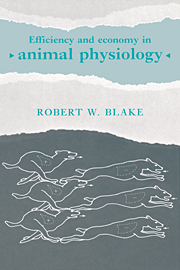Book contents
- Frontmatter
- Contents
- List of contributors
- Preface
- 1 Efficiency, effectiveness, perfection, optimization: their use in understanding vertebrate evolution
- 2 On the efficiency of energy transformations in cells and animals
- 3 Adapting skeletal muscle to be efficient
- 4 Efficiency and other criteria for evaluating the quality of structural biomaterials
- 5 Efficiency and optimization in the design of skeletal support systems
- 6 Efficiency in aquatic locomotion: limitations from single cells to animals
- 7 The concepts of efficiency and economy in land locomotion
- 8 Respiration in air breathing vertebrates: optimization and efficiency in design and function
- 9 Cardiac energetics and the design of vertebrate arterial systems
- 10 An evolutionary perspective on the concept of efficiency: how does function evolve?
- Index
8 - Respiration in air breathing vertebrates: optimization and efficiency in design and function
Published online by Cambridge University Press: 03 October 2009
- Frontmatter
- Contents
- List of contributors
- Preface
- 1 Efficiency, effectiveness, perfection, optimization: their use in understanding vertebrate evolution
- 2 On the efficiency of energy transformations in cells and animals
- 3 Adapting skeletal muscle to be efficient
- 4 Efficiency and other criteria for evaluating the quality of structural biomaterials
- 5 Efficiency and optimization in the design of skeletal support systems
- 6 Efficiency in aquatic locomotion: limitations from single cells to animals
- 7 The concepts of efficiency and economy in land locomotion
- 8 Respiration in air breathing vertebrates: optimization and efficiency in design and function
- 9 Cardiac energetics and the design of vertebrate arterial systems
- 10 An evolutionary perspective on the concept of efficiency: how does function evolve?
- Index
Summary
INTRODUCTION
Efficiency, loosely defined, describes the ease with which a system performs its requisite tasks. By its more strict definition, it describes the ratio of the work produced by a system to the work expended on the system in performing that task. Several papers in this collection argue that the term ‘efficiency’ should be reserved only for the latter case. The former definition is more appropriately referred to as the effectiveness of the system. Thus, the efficiency of a respiratory system will refer only to the ratio of the mechanical work produced by the respiratory pump to the oxidative cost of producing that work. The effectiveness of this performance will also be a function of the many factors which influence the amount of gas exchanged between the environment and the blood for any given level of ventilation. This too can be regarded in terms of an input/output relationship and thus the effectiveness of a respiratory system can be defined as the ratio of the millilitres of O2 exchanged during ventilation to the millilitres of O2 required to power ventilation. The respiratory systems found in vertebrates reflect multiple experiments in design which attempt to optimize gas exchange across the respiratory surfaces given both the respiratory and non-respiratory constraints placed on the systems. Adaptive changes can be found at all levels which contribute both to the effectiveness and efficiency of each system. In the following article, select examples will be used to illustrate some of the trends which optimize the diffusive and convective processes involved in gas exchange (anatomical adaptations and their mechanical consequences) as well as the manner in which they are linked (physiological and behavioural adaptations).
- Type
- Chapter
- Information
- Efficiency and Economy in Animal Physiology , pp. 133 - 158Publisher: Cambridge University PressPrint publication year: 1992



